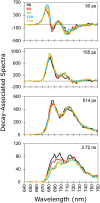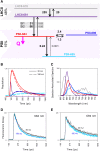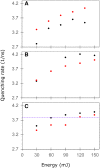Development of fluorescence quenching in Chlamydomonas reinhardtii upon prolonged illumination at 77 K
- PMID: 29948747
- PMCID: PMC6182390
- DOI: 10.1007/s11120-018-0534-8
Development of fluorescence quenching in Chlamydomonas reinhardtii upon prolonged illumination at 77 K
Abstract
Low-temperature fluorescence measurements are frequently used in photosynthesis research to assess photosynthetic processes. Upon illumination of photosystem II (PSII) frozen to 77 K, fluorescence quenching is observed. In this work, we studied the light-induced quenching in intact cells of Chlamydomonas reinhardtii at 77 K using time-resolved fluorescence spectroscopy with a streak camera setup. In agreement with previous studies, global analysis of the data shows that prolonged illumination of the sample affects the nanosecond decay component of the PSII emission. Using target analysis, we resolved the quenching on the PSII-684 compartment which describes bulk chlorophyll molecules of the PSII core antenna. Further, we quantified the quenching rate constant and observed that as the illumination proceeds the accumulation of the quencher leads to a speed up of the fluorescence decay of the PSII-684 compartment as the decay rate constant increases from about 3 to 4 ns- 1. The quenching on PSII-684 leads to indirect quenching of the compartments PSII-690 and PSII-695 which represent the red chlorophyll of the PSII core. These results explain past and current observations of light-induced quenching in 77 K steady-state and time-resolved fluorescence spectra.
Keywords: Photosystem II; State transitions; Target analysis; Time-resolved fluorescence.
Figures





Similar articles
-
LHCSR3 is a nonphotochemical quencher of both photosystems in Chlamydomonas reinhardtii.Proc Natl Acad Sci U S A. 2019 Mar 5;116(10):4212-4217. doi: 10.1073/pnas.1809812116. Epub 2019 Feb 19. Proc Natl Acad Sci U S A. 2019. PMID: 30782831 Free PMC article.
-
Excitation energy transfer in Chlamydomonas reinhardtii deficient in the PSI core or the PSII core under conditions mimicking state transitions.Biochim Biophys Acta. 2016 Jun;1857(6):625-33. doi: 10.1016/j.bbabio.2016.03.002. Epub 2016 Mar 3. Biochim Biophys Acta. 2016. PMID: 26946087
-
Acetate in mixotrophic growth medium affects photosystem II in Chlamydomonas reinhardtii and protects against photoinhibition.Biochim Biophys Acta. 2013 Oct;1827(10):1183-90. doi: 10.1016/j.bbabio.2013.06.004. Epub 2013 Jun 17. Biochim Biophys Acta. 2013. PMID: 23791666
-
Dynamic regulation of photosynthesis in Chlamydomonas reinhardtii.Plant J. 2015 May;82(3):413-428. doi: 10.1111/tpj.12805. Epub 2015 Mar 17. Plant J. 2015. PMID: 25702778 Review.
-
Mechanisms of photoprotection in overwintering evergreen conifers: Sustained quenching of chlorophyll fluorescence.Plant Physiol Biochem. 2024 May;210:108638. doi: 10.1016/j.plaphy.2024.108638. Epub 2024 Apr 19. Plant Physiol Biochem. 2024. PMID: 38653096 Review.
Cited by
-
LHCSR3 is a nonphotochemical quencher of both photosystems in Chlamydomonas reinhardtii.Proc Natl Acad Sci U S A. 2019 Mar 5;116(10):4212-4217. doi: 10.1073/pnas.1809812116. Epub 2019 Feb 19. Proc Natl Acad Sci U S A. 2019. PMID: 30782831 Free PMC article.
References
-
- Allen JF, Bennett J, Steinback KE, Arntzen CJ. Chloroplast protein phosphorylation couples plastoquinone redox state to distribution of excitation energy between photosystems. Nature. 1981;291:25–29. doi: 10.1038/291025a0. - DOI
MeSH terms
Substances
Grants and funding
LinkOut - more resources
Full Text Sources
Other Literature Sources
Miscellaneous

